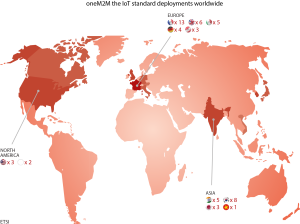5G
oneM2M’s market impact

Over time companies, recognising better business opportunities in the cloud provider market moved their oneM2M teams out of the telco line of business and into the cloud services unit.
oneM2M’s launch 10 years ago targeted two obstacles that could have limited the scale of the emerging IoT industry. These obstacles are related to geographic and technological fragmentation. To address the first obstacle, the regional standards development organizations (SDOs) that founded oneM2M decided to collaborate on a global standard.
To address the second, oneM2M’s standards developers adopted a technology abstraction approach that would accommodate multiple, point technologies across the IoT landscape. They began work by identifying recurring activities in use cases from various vertical applications. This helped to identify commonalities that could be addressed with repeatable and standardized functions. Indeed, oneM2M created an IoT middleware layer comparable to an Operating System (OS).
This layer abstracts the technical complexity involved in connecting sensor devices, gateways, decision making software and visualization dashboards. Moreover, by reusing established technologies and sector specific standards, the standard avoids unnecessary re-invention. As a result, IoT system operators can combine newbuilt facilities, based on oneM2M’s open standard, with legacy sub-systems, even where the latter use proprietary protocols.
SDOs and contributing members envisaged a future where increasing numbers of devices and applications will become connected. They also anticipated requirements that go beyond connectivity along the IoT technology stack. Technical interoperability was a core goal of the oneM2M standard. The future also calls for cross-silo applications and data sharing. These enable innovation and improved decision making. This is what makes oneM2M’s standardization roadmap important and primed for future requirements.
Adoption in smart city scenarios. South Korea saw the earliest adoption of oneM2M standards around 2014. Recognizing oneM2M’s potential to enable IoT platforms, its national government included oneM2M in its Master Plan for Building the IoT. Then, to assist small and medium sized businesses, the government launched an initiative through the Korea Electronics Technology Institute (KETI) and its OCEAN family of open-source utilities and educational initiatives.
In addition to solutions developed by South Korea’s mobile operators, three conurbations deployed complex systems based on oneM2M. The Busan smart city pilot focused primarily on school zone safety, whereas the city of Goyang dealt with smart eco-city services. In the third case, the city of Daegu emphasized healthcare services for the elderly and maternity services for young families. National commitments and pilots led many firms to offer component products and systems based on oneM2M.
“Smart cities” is a recurring theme among other oneM2M deployments. It characterizes multi-stakeholder deployments and the need to manage data from a wide variety of sensors with suitable privacy and security controls. This is where oneM2M’s open standard helps multiple entities to collaborate. It does so by supporting technology-agnostic connectivity, alongside policy-based controls, so that users can define data-sharing permissions.
In Europe, the city of Bordeaux (France) specified oneM2M for its City as a Platform. It wanted to support multiple applications. Beyond technical matters, the oneM2M standards add value to procurement processes. Their use allows municipalities to specify a supplier framework and to procure solutions in a way that reduces the risk of becoming locked in by a proprietary technology or a single vendor.
In Hamburg (Germany), Deutsche Telekom’s Smart City Lab implemented a subset of oneM2M’s common services for connectivity and data management in the mySMARTLife project. oneM2M standards supplemented the Port of Hamburg’s legacy platform, based on the Open Geospatial Consortium (OGC) standard for geo-location, surface planning and measurement activities. oneM2M enabled the sourcing and publishing of city data beyond geo-spatial sources. It also simplified user access to data through an API with configurable access and security capabilities. Working with established sector standards, this example illustrates the role of oneM2M’s interworking framework as a universal hub for modular and standards-based IoT systems.
Multi-stakeholder data market places. Addressing the need for cross-silo collaboration, oneM2M standards were used in the UK on a multi-user, multiuse-case system in the oneTRANSPORT project. This began as a pilot that was partly funded by the Innovate UK agency. oneM2M standards enabled an environment where suppliers and consumers of IoT data could access smart city and transport network data from over two hundred sensor types. The project showcased small, medium, and large-scale use cases. Respectively, these were for a park-and-ride system in the city of Oxford, a system to manage visitor flows at a town-centre soccer stadium in Watford’s town centre and to supervise spectator traffic to the Silverstone Formula One racetrack on the busiest weekend of the year.

Following a successful pilot, the system came into commercial operation. It was then expanded to support data sharing across the Transport for West Midlands footprint. A further evolution involved a data sharing ecosystem for connected vehicles.
Growing adoption across India. In 2020, India’s adoption of oneM2M as a national standard triggered additional deployments. With support from European collaborators, for example, the International Institute of Information Technology, Hyderabad (IIIT-H) launched a Living Lab to work with government bodies, start-ups and large organizations on smart city solutions. Early applications included air pollution monitoring, building energy consumption, water usage and street lighting. IIIT-H later collaborated with the India Urban Data Exchange (IUDX) to enable the use of data for the public good.
IUDX’s open-source software platform is present in 20 cities across India. The IIIT-H/IUDX collaboration allows any registered IUDX user to access sensor data collected from a oneM2M data monitoring capability. This is another demonstration of oneM2M’s role as a technology interworking hub.
Elsewhere, the Indian government’s Centre for Development of Advanced Computing launched its oneM2M-based Common SMART IoT Connectivity (CoSMiC) platform. This platform targets intelligent transport systems by enabling data sharing between IoT field devices and applications in different verticals.
India’s Centre for Development of Telematics (C-DoT) develops new information and communications technologies to meet local market needs in areas related to rural applications, strategic sectors, and security agencies. To this end, C-DOT launched its oneM2M-based C-DoT Common Service Platform (CCSP) with an initial portfolio of 11 applications. While the scope of oneM2M standards is broad, C-DoT’s development team demonstrated oneM2M’s power to support multiple applications using only a sub-set of the standard.
A standards-based roadmap for future IoT systems. As the IoT market expands, industry emphasis is shifting to cross-silo interoperability and innovative use cases. oneM2M is in a unique position to address such developments. That is because oneM2M’s roadmap and release cycle can accommodate new requirements coherently. Release 1, for example, laid the foundations for the oneM2M technical specifications. These specifications were subsequently improved in Release 2 by learning from multi-vendor interoperability testing.
Release 3 added support for 3GPP interworking and security. It also expanded support for sector-specific standards such as OCF, OPC UA, OSGi and Modbus, promoting oneM2M as a system-level standard for integrating sector-specific standards.
oneM2M members will shortly ratify Release 4, while readying new features for Release 5. These features address requirements arising from data privacy frameworks, such as the GDPR and design approaches to handle “AI-for-IoT”. Another important topic, advanced semantic capabilities, aims to make it easier and more dynamic to discover and use IoT data sources in large and distributed systems.
oneM2M has become a mature IoT standard to build on. 3GPP standards laid the foundations for ubiquitous mobile telephony, with a continuous release cycle that is invisible to end users. The same applies to oneM2M. Its cross-vertical approach followed by initial releases and testing events means that oneM2M’s technical specifications now offer a mature set of capabilities. 10 years ago, these would have been innovative. Now, the IoT industry looks on them as a foundation for future IoT systems.
An early contributor to oneM2M reflected on this evolution during oneM2M’s 10-year celebrations. His organization initially marketed their oneM2M-based IoT platform, focusing on connectivity, to telecoms operators. Over time, the company recognized a better business opportunity in the cloud provider and IoT systems market. As a result, they moved their oneM2M team out of the telco line of business and into the cloud services unit. Now, the focus was less about a new standard and more about the services and integration capabilities it enables.
Looking to the future, commercial and regulatory demands will drive new IoT requirements beyond the issue of connectivity. This is evident from the demand for data exchanges that organizations in India are targeting with their oneM2M deployments. Newer deployments will address a broader set of interoperability requirements, which map to the oneM2M standardization roadmap and prospects for the Interoperability of Things.
 Authored by Roland Hechwartner, Chairman, oneM2M Technical Plenary, the article was first published in Enjoy, the ETSI magazine.
Authored by Roland Hechwartner, Chairman, oneM2M Technical Plenary, the article was first published in Enjoy, the ETSI magazine.















You must be logged in to post a comment Login